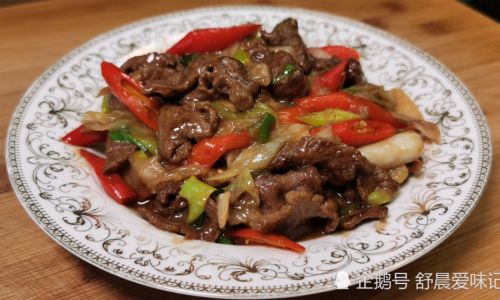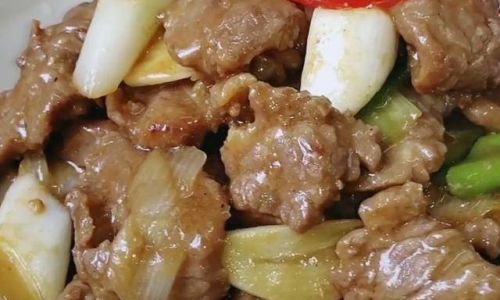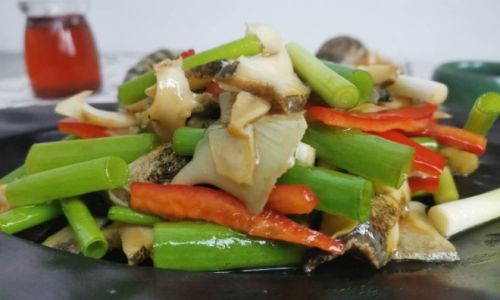Stir-fried beef with green onions, a beloved dish in Chinese cuisine, is celebrated for its harmonious blend of savory flavors and tender texture. Achieving the perfect balance of melt-in-your-mouth beef and crisp, aromatic green onions requires precision, technique, and an understanding of key culinary principles. This article delves into the science and craft behind creating this classic dish, ensuring your next attempt yields restaurant-quality results.
The Foundation: Selecting the Right Beef Cut
The journey to tender stir-fried beef begins at the butcher’s counter. Opt for cuts renowned for their tenderness and quick-cooking nature. Flank steak, sirloin, or ribeye are ideal choices. These cuts boast fine muscle fibers and minimal connective tissue, ensuring they remain tender when subjected to high heat. Avoid tougher cuts like chuck or brisket, which require slow cooking to break down collagen.
When slicing the beef, remember to cut against the grain. This technique shortens muscle fibers, reducing chewiness. For flank steak, identify the grain’s direction (visible as long, parallel lines) and slice perpendicular to them. Aim for thin, uniform strips (about ¼-inch thick) to guarantee even cooking.
The Science of Tenderizing: Marination Magic
Marination is not merely about flavor—it’s a critical step in tenderizing the beef. A well-crafted marinade employs three key elements:
- Acidic Components: Ingredients like soy sauce, rice vinegar, or Shaoxing wine introduce acidity, which denatures proteins and loosens muscle fibers. However, excessive acidity can toughen the meat, so balance is key.
- Enzymatic Agents: Fruits like pineapple or kiwi contain enzymes (bromelain and actinidin) that break down proteins. While effective, over-marination can lead to mushy texture. Use sparingly.
- Cornstarch (Corn Flour): This acts as a protective coating, locking in moisture during cooking. It also creates a silky texture, a hallmark of professional stir-fries.
Classic Marinade Recipe:

- 1 lb beef, thinly sliced
- 1 tbsp soy sauce
- 1 tsp Shaoxing wine (or dry sherry)
- 1 tsp cornstarch
- 1 tsp baking soda (optional, for extreme tenderness)
- 1 tsp vegetable oil
- 1 tsp sesame oil (for aromatic depth)
Combine ingredients, massage into the beef, and marinate for 15–30 minutes. Baking soda raises the meat’s pH, enhancing tenderness, but rinse lightly if its taste is too pronounced.
The Velvet Effect: Water and Oil Management
Tender beef retains moisture. To prevent drying out during high-heat cooking, employ the “velveting” technique. This involves coating the meat in a thin layer of oil (often peanut or vegetable) to seal in juices. Additionally, a quick blanch in oil (or water) before stir-frying can lock in moisture. However, for home cooks, a well-marinated and properly cooked stir-fry often suffices without this step.
Aromatics and Seasonings: Elevating Flavor
Green onions (scallions) are the star aromatic here. Use both the white and green parts: the whites for pungency, the greens for freshness. Slice them diagonally into 2-inch segments to maximize surface area.
Seasoning Sauce:
- 2 tbsp oyster sauce (for umami)
- 1 tbsp light soy sauce
- 1 tsp dark soy sauce (for color)
- 1 tsp sugar
- 1 tsp sesame oil
- 1 tbsp chicken broth (or water)
- 1 tsp cornstarch (for thickening)
Whisk these together to create a glossy, flavorful sauce that coats the beef and onions.
The Stir-Frying Technique: Heat and Timing
Stir-frying is a dance of speed and heat. Follow these steps for perfection:

- Preheat Your Wok: A carbon-steel wok retains heat exceptionally well. Heat it over high flame until wisps of smoke rise. Add 2 tbsp vegetable oil and swirl to coat.
- Sear the Beef: Add the beef in a single layer, ensuring each piece contacts the hot surface. Resist the urge to stir immediately—allow a 30-second sear to develop caramelization. Flip and repeat. Once browned (but not fully cooked), remove and set aside.
- Stir-Fry Aromatics: Reduce heat to medium-high. Add 1 tbsp minced garlic and ginger (optional). Sauté until fragrant (30 seconds).
- Add Green Onions: Toss in the white parts first, stir-frying for 1 minute, then add the greens. Stir vigorously to wilt slightly.
- Reintroduce Beef: Return the beef to the wok, along with the seasoning sauce. Toss rapidly to coat evenly (1–2 minutes). The sauce should thicken and cling to the ingredients.
Pro Tip: Overcooking is the enemy. Remove the beef from heat just before it reaches your desired doneness—residual carryover cooking will finish it.
Common Pitfalls and How to Avoid Them
- Tough Beef: Overcooking or using the wrong cut. Stick to quick-cooking cuts and precise timing.
- Soggy Stir-Fry: Overcrowding the pan. Cook in batches if necessary to maintain high heat.
- Bland Flavor: Under-seasoning. Taste and adjust the sauce before serving.
- Mushy Texture: Over-marinating with acidic ingredients. Limit marination to 30 minutes.
Serving Suggestions and Pairings
This dish shines when paired with steamed jasmine rice, which absorbs the savory sauce. For a complete meal, serve alongside stir-fried vegetables (bok choy, snap peas) or crispy spring rolls. A drizzle of chili oil or a sprinkle of toasted sesame seeds adds texture and heat.
Variations and Creative Twists
- Spicy Kick: Add sliced chili peppers or a dash of Sriracha to the marinade.
- Vegetarian Adaptation: Substitute beef with king oyster mushrooms or seitan, adjusting cooking times accordingly.
- Citrus Zest: Grate a touch of lime or orange zest into the marinade for a bright finish.
The Cultural Tapestry of Stir-Fried Beef
Beyond its culinary appeal, this dish carries cultural significance. In Chinese households, it symbolizes prosperity and togetherness, often served during festivals. The green onions represent longevity, while the beef embodies strength—a meaningful combination for celebratory meals.
Troubleshooting Guide
- Beef is Chewy: Slice against the grain and ensure the pan is hot enough to sear, not steam.
- Sauce is Too Thin: Increase cornstarch by ¼ tsp next time.
- Onions are Overcooked: Add the green parts later in the process to preserve crunch.
Conclusion: The Journey to Stir-Fry Mastery
Creating tender, flavorful stir-fried beef with green onions is an exercise in patience and precision. By selecting the right cut, mastering marination, and controlling heat, you elevate a simple dish into a culinary triumph. Experiment with seasonings, embrace the sizzle of the wok, and soon, your kitchen will rival any takeout joint. Remember: practice makes perfect, and every overcooked batch is a lesson in disguise. Happy cooking!
Word Count: 1,320





0 comments